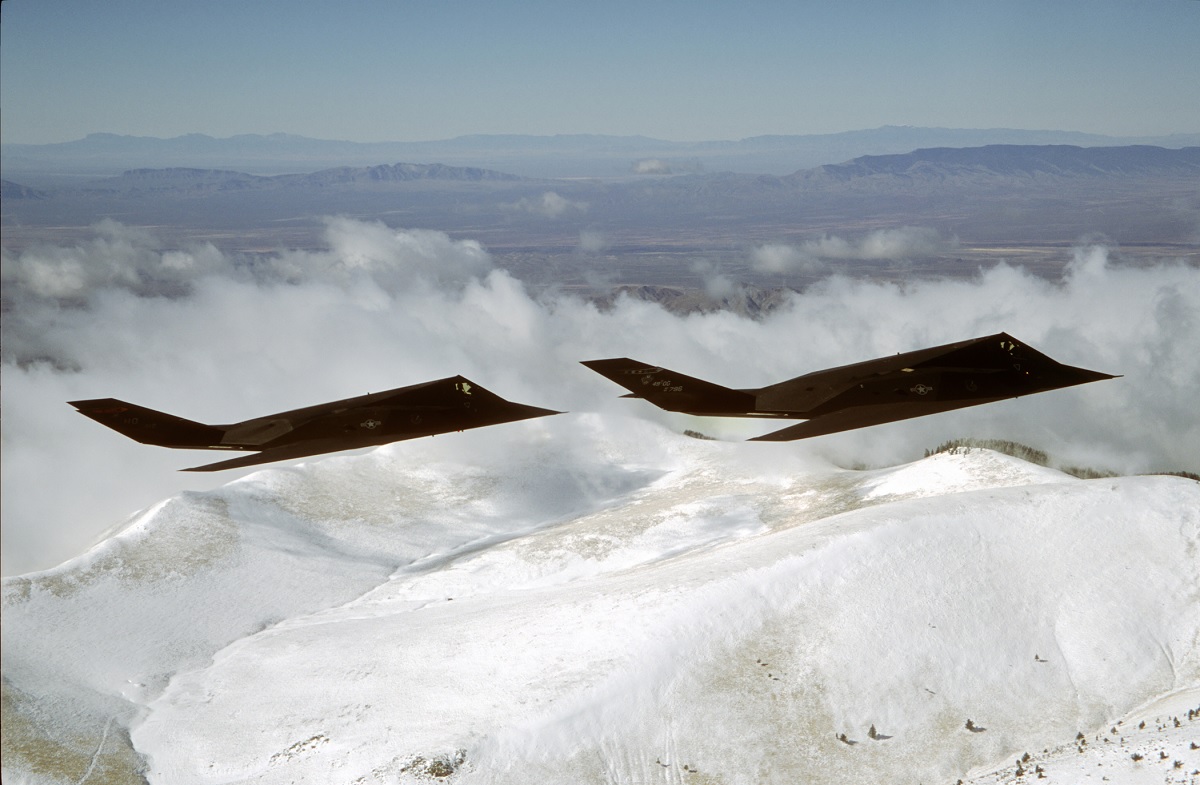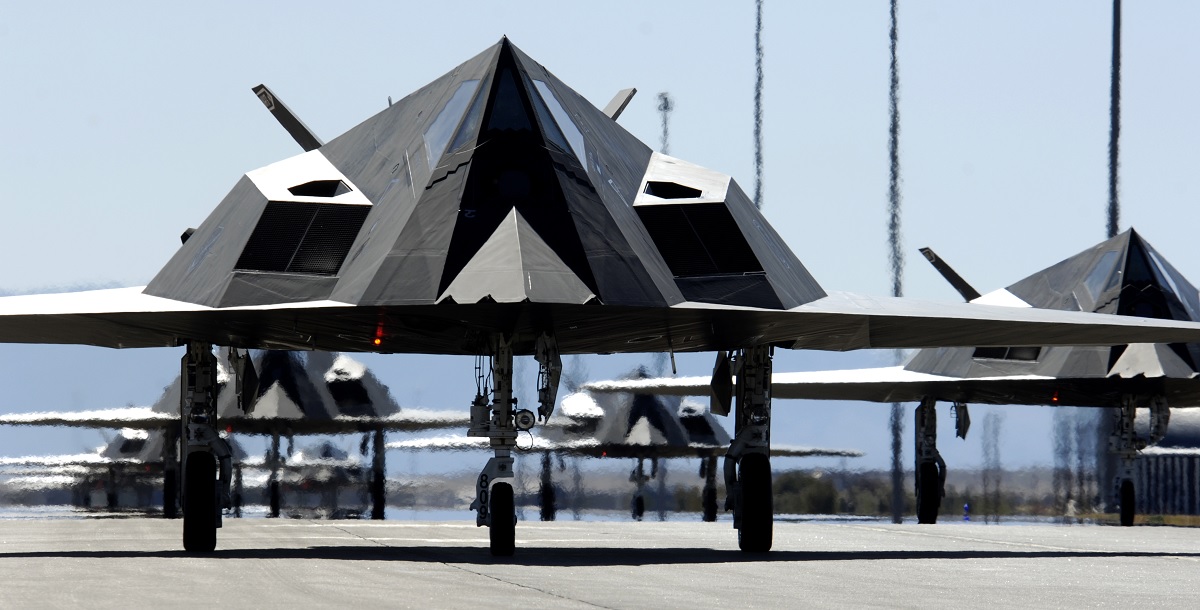Hoehn and Toomey learned that their intended location was maybe where Saddam Hussein, the president of Iraq, was staying
We remember the U.S. Air Force F-117 airstrikes over Baghdad on March 19, 2003, which signaled the start of Operation Iraqi Freedom with the article Bombs over Baghdad, written by Airman 1st Class Emily A. Kenney, 49th Wing Public Affairs.
The morning of Wednesday was gloomy. The black clouds that covered the sky shook with thunder, and rain poured down. Maj. Mark Hoehn, who was stationed with the 49th Fighter Wing at Holloman, observed the sunrise through the clouds, the grays and blues transforming into reds and oranges. Hoehn thought, “Wow, this would be a beautiful sight if I wasn’t about to blow something up.”
He didn’t know who or what his intended target was. Only six hours ago, from Al Udeid Air Base, then Maj. Clint Hinote gave the order “Do whatever it takes to get two aircraft ready for combat tonight.”
Operation Iraqi Freedom started at 5:30 a.m. on March 19, 2003, when the first airstrikes were fired in Baghdad.

“F-117s were used to make the opening attacks on Baghdad on Jan. 17, 1991, the opening salvos on Desert Storm,” said James Burrett, 49th Wing historian. “Just 12 years later, in 2003, F-117s were used again in the first airstrikes over the same city in Iraq at the start of Operation Iraqi Freedom.”
Hoehn claimed to have foreseen this day. He had only shaken hands with President George W. Bush four months earlier when he asked, “You ready?”
Maintainers started preparing two Lockheed F-117A Nighthawk stealth fighters for the mission not long after the order was granted. Hoehn claimed that the crew chiefs and maintainers meticulously checked each plane, making sure it was prepared, using modern GPS weapon technology.
As the deadline approached, then Lt. Col. David Toomey looked at Hoehn and asked, “Fuji (Hoehn’s call sign), are you ready to go?”
“You bet,” Hoehn said.
At approximately 3 a.m. the aircraft were prepared to fight. After a quick prayer, Hoehn and Toomey stepped and boarded their jets.

“We were briefed that we would taxi and take off ‘comms out’, not talking to anybody,” Hoehn explained. “We had folks in the tower that flashed a light gun at us, signaling when we were able to taxi and take off. We went completely stealth, with our antennas in, and anything that would omit a signal turned off.”
They continued up the Persian Gulf, stumbling into a thunderstorm while trying to maintain visual flying.
“I remember looking at the fuel gauge as we were approaching the Iraq and Saudi Arabia border, where the tankers were supposed to meet us, and I was really getting nervous,” Hoehn said. “At that point, I had just enough gas to get back to Al Jaber (Air Base in Kuwait). If I was going to make it to Iraq, I needed fuel and I needed it soon.”
It didn’t take him very long to wait. A KC-135 Stratotanker arrived shortly after to deliver the critical fuel. Toomey first refueled his aircraft before directing it directly north toward Iraq. Hoehn then connected to the tanker and started refueling.
“Sir, it sounds like you’ve got an interesting mission,” said the in-flight refueling specialist. “Can you tell us anything about it?”
“Unfortunately I don’t know much more than you,” Hoehn said. “All I know is to put bombs on coordinates at a certain time.”
Hoehn ordered the refueling tanker pilot to drag him north into Iraq to save time while he was being refueled as the time-over-target (TOT) drew near. He dispersed from the tanker and moved in the direction of his destination once his tank was full.
Hoehn immediately went back into mission mode. He claimed to have observed the Tigris river weaving through Baghdad through the cloud cover.
“I wasn’t able to see my target because of the overcast, but I was able to see landmarks enough to know that my cursor was, if not directly on, within a few meters of the spot I was targeting.”
Even though the target was still hidden, Hoehn released his weapons and used the GPS weapons system to hit the target at precisely 5:30 in the morning. Hoehn and Toomey swiftly turned their aircraft and left Baghdad as soon as the bombs dropped.

“I reached over and pushed the throttle even further forward to get as much speed as possible, and get out of there,” Hoehn said. “I didn’t really start feeling comfortable until at least 30-40 minutes outside of Baghdad. Then I thought, what’s next? I hadn’t really thought it through this far in the mission, and once again, I was running low on fuel.”
Hoehn turned on his antennas and radioed the Airborne Warning and Control System at that point (AWACS). He informed AWACS of his general location and received instructions on where to locate a tanker for refueling.
He flew to the tanker track area in the south after spotting a tanker waiting. When he hooked up, he recognized the tanker as the one that had previously refueled him.
The same in-flight refueling specialist asked, “So how did everything go?”
“Well, I’m about 4,000 pounds lighter,” Hoehn said. “I can’t wait to go back and find out exactly what we hit, but you guys were a big part of it.”
In order to readily communicate with the Air Traffic Controllers at Al Udeid, Hoehn flew the same path on his return trip.
“When I landed and pulled back into the hangar, there were probably 100 people there,” Hoehn said. “Nobody slept at all. All the maintainers and the rest of the squadron were there. As the doors opened, everyone tried to look and see if the bombs were gone, and when they saw that they were, everyone cheered.”
Hoehn and Toomey learned their destination was where Saddam Hussein would be living during the mission debrief. Even though they missed Hussein that evening, Hoehn thinks that the attack made Hussein frightened and act sporadically, making him vulnerable to capture later.

Photo by Staff Sgt. Aaron D. Allmon II, Airman 1st Class Emily A. Kenney, and Senior Airman Brian Ferguson / U.S. Air Force

